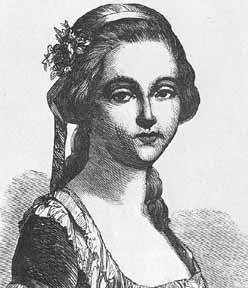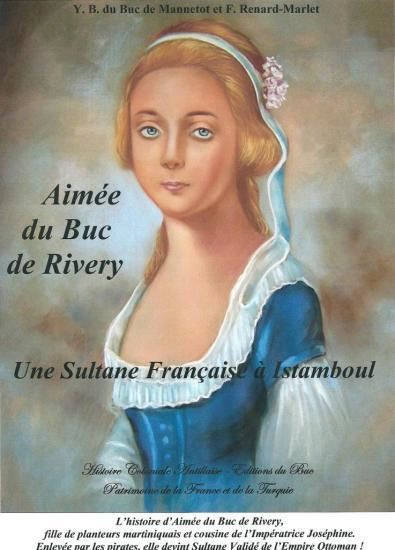Disappeared August 1788At sea Name Aimee Buc Religion Catholicism | Ethnicity French Status Missing | |
 | ||
Full Name Aimee du Buc de Rivery Born 4 December 1768 | ||
The Legend Of Aimée du Buc de Rivéry
Aimée du Buc de Rivéry (4 December 1768 – ?) was a French heiress, a cousin of Empress Josephine, who went missing at sea at a young age. There is a legend that she was captured by Barbary pirates, sold as a harem concubine, and was the same person as Nakşîdil Sultan, a Valide Sultan (Queen Mother) of the Ottoman Empire, though there is no evidence of this.
Contents
- The Legend Of Aime du Buc de Rivry
- Life
- Legend about her being Valide Sultan Nakidil
- Controversy over the legend
- Popular fiction and uncritical recounts
- Literature
- References

Life

Aimée was born the daughter of wealthy French plantation owners in Pointe Royale, south-west of Robert on the Caribbean island of Martinique. After being sent to a convent school in France, she was returning home in July or August 1788 when the ship she was on vanished at sea. It is thought that the ship was attacked and taken by Barbary pirates. It has been suggested that she was enslaved and eventually sent to Constantinople as a gift to the Ottoman Sultan by the Bey of Algiers.
Legend about her being Valide Sultan Nakşidil

(This story is the legend of Aimee in the Ottoman palace harem and is not rooted in historical fact)
According to the legend, Aimée became the wife of the sultan, taking the name of Nakşidil. She introduced French ideas to the Ottoman people, especially the sultan, and her French-style reforms may have led to his death at the hands of the Janissaries and the Ulema, which were against the liberalization of the empire. During the rule of Abdul Hamid I, Aimée taught him French; and for the first time, a permanent ambassador was sent from Constantinople to Paris. Selim started a French newspaper and let Nakşidil decorate the palace in rococo style, which was popular in France at that time. Aimee bore a son named Mahmud II, who became sultan after his father's death.
The assassins, aided by the Ulema, also sought to kill Mahmud, but Nakşidil saved her son by concealing him inside a furnace. Thus Mahmud became the next Sultan, accomplishing significant reforms in the society and military of the empire that were, for the most part, attributed to the influence of his mother.
It was furthermore reported that it was Aimée as Nakşidil who forced her son to sign peace between Russia and the Ottoman Empire in 1812, just to have a revenge on Napoleon who had divorced her cousin Joséphine and married Marie Louise. With the peace on the Ottoman border, the Russian Emperor was free to war against the man Aimée had a personal interest in seeing humbled.
Although Aimée accepted Islam as part of the harem etiquette, as well as the religion of her husband, she always remained a Roman Catholic in her heart. Her last wish was for a priest to perform the last rites. Her son did not deny her this: as Aimée lay dying, a priest passed for the first time through the Seraglio, to perform the Holy Sacrament before her death. Her tomb lies not far from the Hagia Sophia.
Controversy over the legend
Researchers have looked into the alleged history of Aimée du Buc de Rivéry in the royal harem and found it implausible.
According to Turkish historian Necdet Sakaoğlu, Nakşîdil Sultan was ethnically Georgian in origin.
While several stories state that Aimée was abducted in 1781 - untrue but early enough that the seventeen year old could have been the mother of Mahmud II, born in 1785 - other stories account for the fact that Aimée was well in France with her family until the year 1788 at least. In the latter recounts of the tale, Aimée is only the foster mother to Mahmud II, while his birth mother died in his childhood.
None of the fictional accounts however are considering the single contemporary (yet also unreliable) source from the year 1817: Nakşidil was reportedly abducted when she was still two years old. That version of her story makes it impossible for her to be identical with the missing Aimée.
Robert Vine wrote: "The myth of two cousins from a Carribean [sic?] island becoming respectively the wife of the French Emperor and the mother of the Ottoman Sultan has an obvious romantic attraction - but by the same token, is highly improbable, unless provided with solid factual proof".
There are however indications that the seeds of the legend have been carefully planted. Several older myths, dating back even to the early 16th century, already purported connections between the French and the Ottoman monarchy, but have been traced to be politically motivated fabrications, so that alliances between the respective monarchs were seen as justifiable. The Aimée-Nakşidil tale distinctly parallels to these older tales. In times of monarchy, the stories about abducted French princesses weren't repudiated to maintain good relations - in fact, both Napoleon III and Abdülaziz were pleased to announce their kinship to each other, years later. In later times this and similar harem tales have been used to perpetuate the prejudice of Turkey, the Middle East and the Islam in general as mysterious and despotic in nature, despite more accurate accounts available. The legend furthermore reinforced prejudices of the Ottoman Empire as a backwater country, where even a western slave consort was able to initiate an overdue modernization while the primitive natives couldn't conceive necessary reforms.
